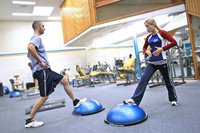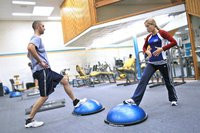 23rd Jun 2015
23rd Jun 2015
Popular Treatments for Sports Injuries
When people have sports injuries, generally they want to throw some ice on it and call it a day, if they even do that. Unfortunately, some injuries can be persistent and begin to effect functional mobility. When this happens, it’s time to seek treatment from a physical therapist. Not only can a physical therapist help a patient regain functional mobility, but they can also help them decrease pain resulting from the injury. In addition to an exhaustive knowledge of anatomy and physiology, a physical therapist will use a multitude of modalities and exercises tailor picked to get a patient back to their daily activities in the most efficient amount of time. Let’s break down some types of treatments a person can expect to receive in the course of their physical therapy treatment.

Physical Therapy can Help Heal Sports Injuries
Types of physical therapy treatments
1.Exercise: Unlike the exercise a patient might use for physical fitness, the exercise used in physical therapy can be passive or active. Exercise is simply physical stress placed on the body with the goals to improve strength, flexibility and range of motion. In passive exercise, a patient is required to relax while the physical therapist applies a certain amount of stress.
2.Ultrasound: Ultrasound uses deep heat to treat a variety of sports injuries: sprains, strains, tendonitis, etc. Using an ultrasound machine, a physical therapist will press a wand (called a sound head) gently to a patient’s skin and move in small circles near the injury.
3.Electrical Stimulation or TENS: This machine uses electrical transmission to decrease pain. Electrodes are placed near the injury and when the machine is turned on, electrical current is sent through the electrodes. The patient will feel a slight tingling. Electrical stimulation is successful in disrupting the pain signal sent from the injury to the surrounding nerves. Breaking this signal decreases pain.
4.Joint mobilization: The physical therapist will passively move the joints of the patient’s body in specific directions, helping decrease pain and improve mobility. There is a gliding motion that happens between the joints of the body and joint mobilizations help increase that gliding motion.
5.Whirlpool Therapy: Hydrotherapy is my personal fave. This modality can help circulation and control inflammation. Whirlpools can be hot or cold. A whirlpool therapy session will include placing the body part in water while the water swirls around it.
6.Laser or Light therapy: Light therapy helps decrease pain and inflammation. It involves using a light at a specific wavelength held over the injury for a set length of time, usually 1-2 minutes. Laser therapy helps the healing process for the injured tissues.
7.Massage: Unlike the relaxing treatment someone might have at a spa, this type of massage has a different intention and is more specific. Kneading the injured tissues can help decrease pain and muscle tension and improve your circulation.
Ice also makes the list as does heat, but you can see the tools a physical therapist will use to treat sports injuries is much more comprehensive and targeted then anything a person could do on their own. When treating sports injuries, it’s important to remember physical therapist’s as a patient’s own personal healthcare companion. Their goal is to get patients moving again, pain-free. And we don’t have to wait for a super-smart science dude to invent them





